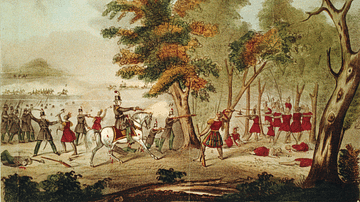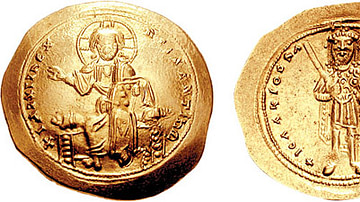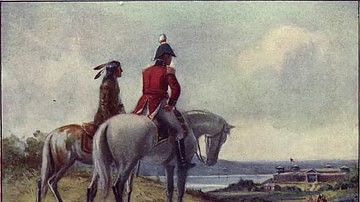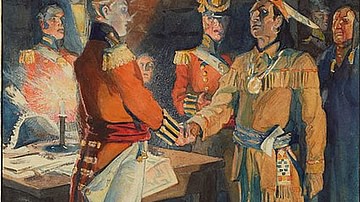The Siege of Detroit (15-16 August 1812) was one of the first major actions of the War of 1812. After a botched invasion of Canada, a US army retreated to Fort Detroit, where it was besieged by British and Native American forces under Major General Isaac Brock and Shawnee chieftain Tecumseh. The Americans quickly capitulated, leaving Detroit in British hands.

Background: March to Detroit
By April 1812, war between the United States and the United Kingdom seemed just over the horizon. On the high seas, British warships had been boarding American merchantmen and impressing American sailors with impunity, while on the northwestern frontier, British agents were believed to be aiding two Shawnee brothers, Tecumseh and the Prophet, in their attempt to form a Native American confederacy and resist US encroachment onto their hunting grounds. In Congress, a clique of belligerent, newly-elected representatives – called 'War Hawks' – clamored for war, despite the reluctance of the general population and the underpreparedness of the military. To prepare for a conflict that seemed increasingly likely, the administration of President James Madison looked to shore up defenses in the northwest, where the US shared a border with British-controlled Canada.
As part of this plan, the Madison administration ordered a new army to be raised in the Michigan Territory and then marched to the outpost of Fort Detroit. William Hull, the 59-year-old governor of the Michigan Territory, was commissioned as a brigadier general and offered the command. Hull, a veteran of the American Revolutionary War, was reluctant to accept – he had, after all, recently suffered a stroke – but his fear of an increase in Native American attacks against Michigan settlers led him to take the command. On 25 May, Hull arrived in Dayton, Ohio, where his makeshift army was being assembled, and was dismayed at what he found. The volunteers were noisy and undisciplined, lacking adequate arms or powder. Organized into three militia regiments, the volunteers insisted on electing their own officers. As such, the men they selected as colonels – Duncan McArthur, James Findlay, and Lewis Cass – were all either politicians or aspiring politicians, men with no military experience.
After a botched army inspection in which Hull was nearly flung from his horse, the army of Ohio volunteers set out on 1 June. Proceeding at a slow pace, they reached the frontier community of Urbana ten days later, where they were joined by Lt. Colonel James Miller and a regiment of regulars, the 4th US Infantry. At Urbana, some of Hull's volunteers refused to go any further, claiming that they had not received the full pay that had been promised to them. Though they were eventually prodded along by Miller's regulars, it was not a promising start. A few days later another incident took place when one militiaman, drunk on moonshine, was startled by a noise in the dark and shot one of his fellow sentries. The man was promptly court-martialed and given the "grotesque sentence" of having his ears cropped and each cheek branded (Berton, 94). The army then marched into the Great Black Swamp, northwest of Ohio, where incessant rainfalls had overflown streams and turned the ground to mud. Meanwhile, they were, unbeknownst to them, being closely watched by Tecumseh's scouts, hiding amongst the trees.
On 26 June, Hull received a letter from the US Secretary of War dated 18 June, warning him that war was imminent and ordering him to get to Detroit "with all possible speed". On 1 July, Hull reached the mouth of the Maumee River where he hired the schooner Cuyahoga and loaded it with anything that was slowing the army down, including his personal dispatches, officers' baggage, extra uniforms, medical supplies, and around 30 sick men. The Cuyahoga then sailed into Lake Erie to transport the supplies to Detroit. The next day, Hull received a second letter from Washington, also dated 18 June, informing him that war had been declared, but it was too late to recall the schooner. As it attempted to enter the Detroit River, the Cuyahoga, carrying Hull's dispatches, was captured by a Canadian vessel. On 5 July, Hull finally reached Detroit, where he was joined by several companies of Michigan militia, bringing his total number to about 2,500 men. Hull, whose army was running dangerously low on supplies, had hoped to find food in Detroit but was disappointed.
Invading Canada
With war now declared, the War Hawks back in Washington clamored for an invasion of Canada. Their objective was not only to deny the British a staging ground from whence they could attack the United States but also to finally bring Canada into the Union and thereby, as one congressman put it, "drive the British from our continent" (Berton, 98). To this end, the Madison administration planned a four-pronged invasion into Canada, of which Hull and his ragged army were to comprise one of the main thrusts. Hull was ordered to cross over the Detroit River and seize control of Fort Malden at Amherstburg, known to be defended by a garrison of 300 British regulars and 400 Native Americans under Colonel Henry Procter. Control of Fort Malden would allow Hull to march into Upper Canada virtually unopposed. Though he had the numerical advantage, Hull was worried by his lack of food and the undisciplined nature of his troops and was fearful of the Native Americans who seemed poised to join the British. Around this time, Hull sent a message to a Wyandot village opposite the British fort. In it, he asked that Tecumseh – the great Shawnee leader who was trying to build a Native American confederacy – remain neutral in the coming struggle. It was not long before Hull received Tecumseh's reply:
I have taken sides with the King, my father, and I will suffer my bones to be bleached upon this shore before I will recross that stream to join in any council of neutrality.
(Berton, 123)
Despite these foreboding words and his own reluctance, Hull decided to go ahead with the invasion. On 10 July, he ordered his army to cross the river into Canada, only for many of his Ohio militiamen to refuse; they had been recruited as a purely defensive force, they argued, and were not obliged to fight outside the United States. This led to two frustrating days of stagnation before Hull was finally able to goad the army across the river on 12 July, though he was forced to leave 200 of the most stubborn militiamen behind. The Americans landed unopposed at the small village of Sandwich, where Hull proceeded to issue a proclamation to the Canadian people, explaining the purpose of his invasion. The US general promised that he had come "to find enemies, not to make them", and urged the Canadians to either join the American side or remain in their homes; unless they took up arms against the United States, he promised they would not be harmed (Berton, 127). Hull's words appealed to many of the nearby Canadian militia, many of whom felt no great attachment to either Britain or the United States and were in no hurry to die. As many as 500 men deserted the Canadian militia in the days following Hull's proclamation.
As far as invasions go, this was a good start. The American army hunkered down at Sandwich to wait as Duncan McArthur's militia regiment foraged for food in the homes and farms along the Thames River. In the meantime, Colonel Cass's militia, which had been the first to set foot on Canadian soil, was now determined to be the first to move against the British as well. Cass led his men to the bridge over the Canard River, where they engaged in a brief skirmish with the British sentries there. The redcoats were soon chased off, leaving two of their wounded behind; one of these, James Hancock of the 41st Regiment, died of his wounds that evening, making him the first combat death of the war. Encouraged by this small success, Cass rushed back to Sandwich to urge General Hull to press on and attack Fort Malden. But Hull did not want to begin the attack without the "absolute certainty of success" and insisted they wait for the artillery to be ready (Berton, 138). Cass, therefore, had no choice but to pull his men off the bridge, and the American army continued to wait. As it did so, there was more violence; American Captain William McCullough killed and scalped a Native American, writing to his wife how he tore the scalp from the corpse with his teeth (ibid).
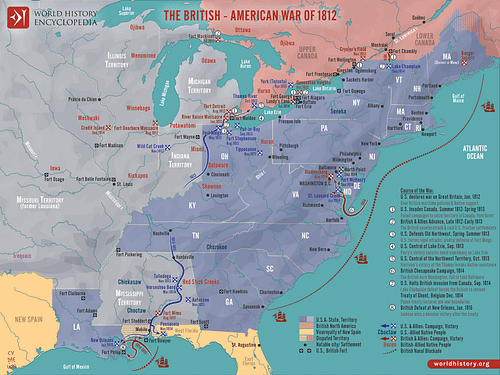
On 26 July, Hull received news that rattled him to his core. Nine days prior, the small American garrison on Mackinac Island – a small island between Lake Huron and Lake Michigan – had surrendered to a combined force of British troops and Native American warriors. The victory had apparently emboldened more Native Americans, including the previously neutral Wyandot, to side with Britain. Hull had long been terrified of Native Americans; as governor of a frontier territory, he had heard stories of White captives being scalped or tortured by Native American warriors after a battle. And now, to use Hull's own words, it seemed as if a "hive of Indians" had opened in the north and would soon come "swarming down in every direction" (Berton, 140). On 5 August, a detachment of 200 US soldiers under Major Thomas Van Horne had moved to the Michigan side of the river and was marching south to gather supplies for the army at the Maumee Rapids. Near the settlement of Brownstown, they were ambushed by a party of Native Americans under Tecumseh. In the brief skirmish that followed, 18 US soldiers were killed – including Captain McCullough, who was himself tomahawked and scalped – with 12 others wounded and 70 missing. Tecumseh had lost only one man and, moreover, captured more of Hull's dispatches, detailing the general's plans and dispositions.
Retreat to Detroit
News of the defeat at Brownstown left Hull more nervous than ever. On 6 August, he finally ordered his men to prepare to attack Fort Malden only to retract that order the next day, upon learning that boats full of British regulars and Canadian militia were rowing across Lake Erie. Fearing that he was about to be cut off from US territory, Hull ordered a retreat to Detroit, despite the protestations of his officers. Hull knew that he would need more supplies if he were to make a stand at Detroit, and ordered Lt. Colonel James Miller to go to the Maumee Rapids and gather the supplies that Van Horne had been prevented from obtaining. Miller set out ahead of the main army with 280 regulars and 330 Ohio militia, making it as far as the town of Maguaga, where, on 9 August, he encountered a mixed force of British regulars, Canadian militia, and Tecumseh's natives. After a brief, yet confused battle, the Americans retained control of the field – but at the cost of 70 casualties, compared to less than 30 casualties for the British and natives. Miller was visibly shaken by the skirmish and, terrified of another ambush, refused to push forward. After several unsuccessful attempts to shake Miller from his daze, Hull finally relented and ordered the detachment to rejoin the army at Detroit.

Meanwhile, on 13 August, the boats of British reinforcements landed at Amherstburg. They were led by Major General Isaac Brock, the tall, burly commander of Upper Canada, who had spent the previous few weeks mustering militia and preparing to meet the invasion. Upon learning that Hull had retreated, Brock was eager to go after him and lay siege to Detroit, and immediately began making plans. He spent hours poring over the captured American dispatches, from which he learned two valuable pieces of information: the first being that the US army was largely comprised of undisciplined militia, the second that Hull was deathly afraid of Native Americans. Close to midnight, Brock was introduced to Tecumseh, who agreed to aid in the attack. As the two men stood there, looking over maps and dispatches, the British general and the Shawnee chieftain took the measure of one another. Of Tecumseh, Brock would later write that "a more sagacious and gallant warrior does not, I believe, exist. He was the admiration of everyone who conversed with him" (Berton, 169). Tecumseh's opinion of Brock was more succinct but held just as much esteem: "This is a man."
The Siege
By 12 August, the American army had returned to Detroit. Morale was low and the air was thick with mutiny. Some of the rank and file began plotting to depose Hull and replace him with the more aggressive Colonel McArthur, while some of the officers took the more formal route of writing to the governor of Ohio complaining about their cowardly general. Hull was certainly aware of these plots and, on 14 August, dispatched McArthur, Cass, and 350 of the most discontented men to escort a supply convoy to the fort. While this temporarily rid Hull of the worst malcontents, it also significantly weakened his garrison. Around that time, Hull received a letter that had been intercepted from the British, one that made him wish he had not sent so many men out of the fort. The letter asked that no more Native Americans be sent to Amherstburg; there were already 5,000 there, ready to attack Detroit, and supplies were too low to accommodate any more.
The letter, of course, was a lie. Brock, playing up to Hull's fear of Native American warriors, had significantly overstated their number at Amherstburg and had allowed the letter to fall into American hands. In truth, Brock had no more than 1,300 soldiers and 600 Native American warriors, a force half the size of Hull's own. But the letter was only the beginning of Brock's psychological warfare. Moving his army within sight of Detroit – but still on the opposite side of the river – he lit more campfires than he needed to create the illusion of a larger army and outfitted his militia in extra uniforms from the 41st Regiment to make it look like he had more regulars than he did. To cap it all off, Brock sent a message to Hull demanding the fort's surrender and warning that, in the event of an assault, he may be unable to call off his Native American allies:
It is far from my intention to join in a war of extermination; but you must be aware that the numerous body of Indians who have attached themselves to my troops will be beyond my control the moment the contest commences.
(Berton, 175)
Hull was certainly shaken but refused Brock's request to surrender, instead sending a messenger out to recall McArthur and Cass to the fort. On 15 August, the siege began; a British battery, established on the Canadian side of the Detroit River, opened fire at the fort, a bombardment that lasted all afternoon. Then, in the early hours of 16 August, Tecumseh led his warriors across the river, followed closely by Brock's troops. Brock moved his troops around to the back side of Fort Detroit where the defenses were weakest. Meanwhile, Tecumseh paraded his warriors through an open gap in the woods, having each man circle back and repeat the march three times, thereby keeping up the illusion that there were thousands of them. The fort's undisciplined defenders were soon rattled by the roar of British artillery mixed with the shrill war cries of the Native American warriors. Whatever resolve they had left was shattered when a British shell exploded in the officer's mess, killing seven Americans and wounding several others.
By now, Hull was convinced that the fort would fall and, remembering Brock's warning, knew he had to act fast to prevent a massacre. He raised the white flag of surrender over Detroit just as Brock was preparing to order the assault and, a few hours later, the British general rode into the fort while military bands triumphantly played "The British Grenadiers". Many of the American soldiers had wanted to fight and cursed Hull as a traitor as the redcoats poured into the fort. McArthur and Cass, who had spent the night rushing to the aid of Detroit, returned in time to see the Union Jack raised above the fort, leading Cass to cry that Hull had disgraced his country before breaking his sword across his knee. Upon Hull's surrender, the 1,600 Ohio militia were paroled and allowed to go back south, while the 582 captured regulars were shipped off to Quebec City as prisoners of war; some of the less healthy men would not survive the journey. As the surrendered US troops were being rounded up, Tecumseh entered the fort; one eyewitness would later remember the great chieftain sitting in the fort and smoking his pipe, "his face perfectly calm, but with the greatest satisfaction beaming in his eye" (Berton, 190).
Conclusion
The fall of Detroit not only gave the British a toehold on US territory but also inspired more Native Americans to rise up and attack US settlements. In Canada, Brock was hailed as a hero and Tecumseh's Native American confederacy seemed one step closer to coming to fruition. Blame for the defeat was heaped on Hull's shoulders. In 1814, he would be court-martialed and sentenced to death; however, President Madison would commute the sentence to dismissal from the army, in recognition of Hull's service in the American Revolution. After the fall of Detroit, the Americans attempted another invasion of Canada, which resulted in the Battle of Queenston Heights (13 October 1812).






